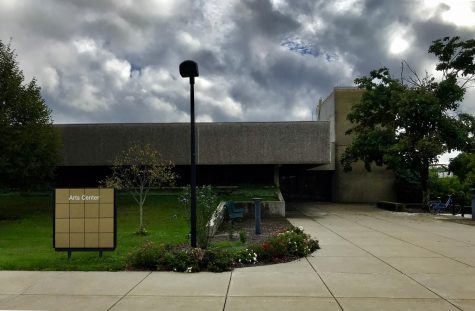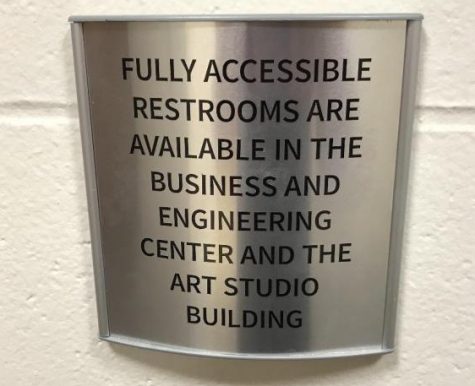‘No way to make it fully accessible’
A look inside the Arts Center, and its lone restroom
Parker Grace had just started working on an assignment when he had to use the restroom in the middle of class.
Grace had a problem though, he was on the first floor of the Arts Center.
The freshman undecided major did not want to walk to the lower level to use the Arts Center’s single restroom.
“It’s a waste of my time to walk all the way there, they need to have a bathroom on each floor,” he said.
The two-story Arts Center only has one dedicated restroom, and it’s located on the lower level.

Grace said it was unbelievable to him as a first-semester freshman that more had not been done earlier to address a basic need for everyone, using an accessible restroom.
University ADA Coordinator Douglas Goeppner said he was aware of Arts Center restroom lacking certain measures, including basic accessibility for handicapped individuals.
The Americans with Disabilities Act (ADA) works to ensure equal access for people with disabilities and establishes certain design requirements for the construction and alteration of facilities.
The act also covers those with a physical or mental impairment that seriously hampers a major life activity. It protects those suffering from a history of disabilities.
The university created the ADA coordinator position years ago to provide an in-house resource with expertise on the act.
Grace said the layout of the Arts Center needs to undergo a major renovation. He said lighting and overall cleanliness has deterred him from wanting to use the building more often.
“The doors are disgusting, they are scratched up, and if you go in the front doors that lead you to the stairwell that takes you downstairs, the lighting is inadequate,” he said.
He said the layout could also be a lot more spacious so students who are a part of an art major or minor can take full advantage of the building.
Graphic design major Utah Ponce said he’s grown used to the arts center layout, including lack of restrooms on each level.
“Bathrooms being in the basement is a huge inconvenience,” he said. “The bathroom itself is fine, but the walk to and from is very inconvenient, be it if you’re visiting the building or have classes on the main floor.”
The senior said the university should absolutely be open to renovation and improvements of the Arts Center.
“At no point do I remember improvements being made to the building other than some new furnishings in one classroom last year,” Ponce said.
The Arts Center was last renovated in 2014 and 2015 but most of the work completed was on the lower level according to Director of Facility Operations and Planning Jim Wolfe.
Ponce won’t see any upgrades in the near future either.
“There are no plans for any further remodeling or renovation of the Arts Center at this time,” university spokesman Ben Luttrull said in a statement.
Ponce also said much of the equipment in the photography lab is in need of repair and maintenance.
“We have a lot of loyal, devoted students that work hard and pay a lot of money to be here just like everybody else,” he said. “It would be great to see our place of work treated with the same reverence as other portions of the university.”
As for Grace, he said he hopes to the building will be improved so future generations don’t have to deal with the unneeded worry of where to go to use the restroom.
“You see all the other buildings around it like the (David L. Rice) library, and the L.A. (Liberal Arts) buildings are all huge and just look better,” Grace said.
The restroom sign
Goeppner said a sign recently placed in front of the restrooms in the lower level of the Arts Center indicating that “fully accessible restrooms are available in the business and engineering center and in the art studio building,” is ADA compliant.
“That sign reflects our efforts to comply with very specific ADA standards,” Goeppner said. “We provide that information that is pretty important for accessible restrooms. The sign is for people with disabilities who might otherwise not know.”

He said if a restroom cannot be made accessible there is a requirement to put an informational sign indicating the nearest accessible restroom.
“The sign that has recently appeared, that does reflect compliance,” Goeppner said.
He said the main issue is the age of the building, which was originally built as the technology center in 1975 when the university was still Indiana State University – Evansville.
“We are dealing with an old building,” he said.
Goeppner said there is a compliance distinction between existing facilities and those built before the 1990 ADA law took effect, including the Arts Center.
“The Arts Center was built way before the required standards for accessibility,” he said. “Standards actually recognize citations in older buildings, technically it is infeasible to fully comply with standards as we understand today and this is the problem with art center.”
He said little to no thought about accessibility was reviewed at the time of building construction.
“Restrooms do have some accessibility features, but the way they were built does not allow for all the updates to make them fully accessible, some but not fully, because of the limitations of the building,” he said.
Goeppner said it would be technically infeasible to make the bathrooms fully accessible.
“No way currently exists to make that happen,” he said.
Acknowledging the limitations with the arts center only having one set of restrooms, Goeppner said older buildings can get a little squirrely.
“I would like everything to be more accessible in general,” he said.
He said the restrooms met code under facilities operations back in the 1970s, and still technically do, but there is more that could be done.
Behind the scenes of the Arts Center
A member of the art department who spoke on condition of anonymity for fear of retribution, said students and faculty, predominantly women have long complained about the distance to the lower level bathroom and lack of ventilation.
“I feel like the bathroom was not thought through, about the overall usability, and what kind of people can use it,” the source said. “This impacts outreach and the planning of potential events.”
The source said when compared to other buildings at the university, such as the neighboring Romain College of Business and David L. Rice Library, the issue seems clear as “night and day.” The source said the dark room and the potter’s wheel, is currently not wheelchair accessible.
Interim Chair of Art and Design Katie Waters said the one restroom does not reflect well on the university as a whole.
“It’s certainly not the optimal situation,” she said. “Everyone in this building would like to have facilities on the (first) floor as well as the lower level. It’s quite inconvenient.”
The longtime professor of art said originally there was supposed to be an additional floor on the building.
“That’s why it looks like an airplane,” she said. “By the time USI got funding for expansion, this building was already out of code, so the second floor was never built.”
She said the restrooms on the lower level were up to code at the time the building was completed. She said students have complained about the walk to the lower level bathroom for years.
“It would be near impossible, to bring those bathrooms and make them totally ADA and handicap accessible,” Waters said. “They have improved them as much as they could.”
Waters said she thinks the university has thought about the bathroom situation on the lower level.
“Is it the best situation? Of course, it’s not,” she said.
